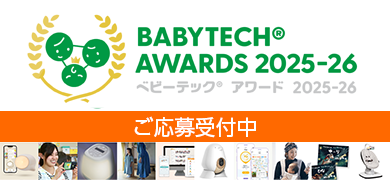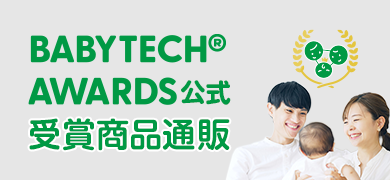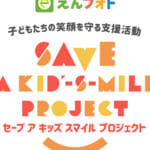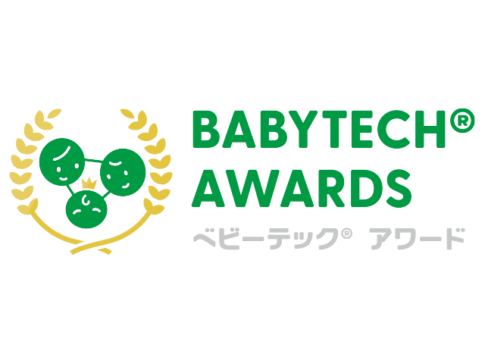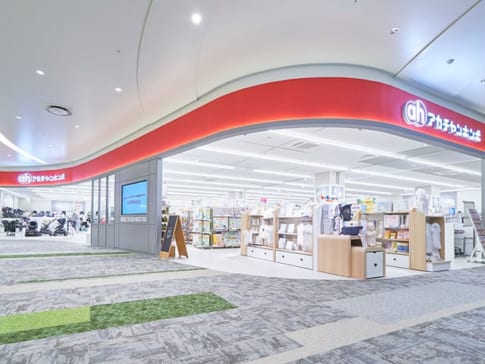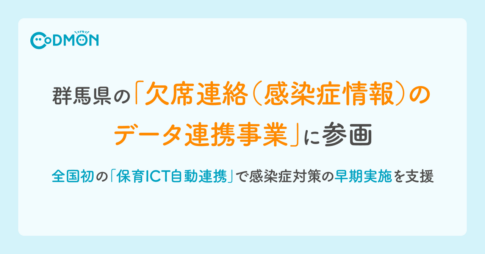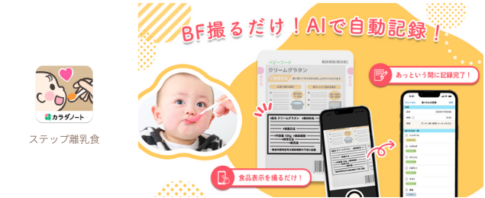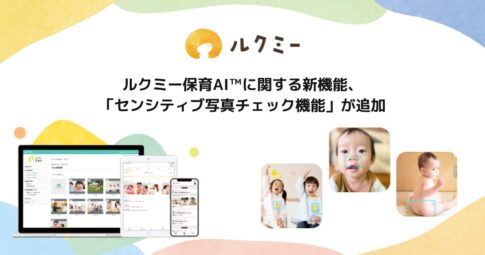- The following is content from the press release -
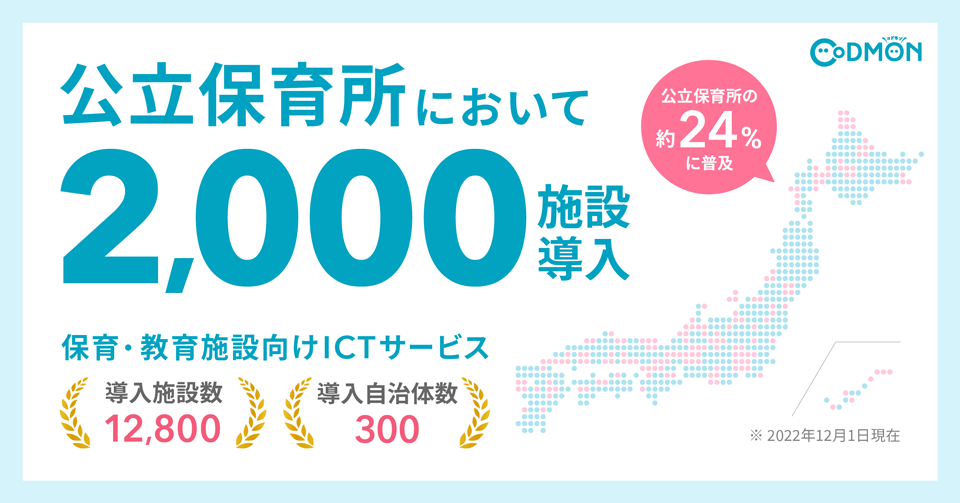
(Head office: Minato-ku, Tokyo; Representative Director: Yoshinori Koike), a provider of CoDMON, an ICT service for childcare and educational facilities, announces that 2,005 public daycare centers and other facilities nationwide have already installed CoDMON as of Wednesday, December 14, and that approximately 24%(*1) have already installed CoDMON. We are pleased to announce that approximately 241 TP6T(*1) have already installed Codomon.
Codomon has been introduced in 309 municipalities nationwide, and the number of municipal employees using the service has reached 53,307. Codomon is Japan's largest ICT service for childcare and education facilities in Japan (*2), and we will continue to introduce the service in order to contribute to the reform of work styles of DX and public daycare centers in local governments nationwide. We will continue to introduce the system to all municipalities in Japan that have public daycare centers. We will continue to work with local governments nationwide to realize a world in which society as a whole can support children's growth and learning.
(*1) Approximately 24% is calculated based on the number of public daycare centers and certified kindergartens introduced to 2,005 facilities and the number of public daycare centers and certified kindergartens nationwide as 8,101 facilities. Public daycare centers and certified child daycare centers include only publicly operated daycare centers and certified child daycare centers, and do not include publicly operated and privately operated facilities.
→Survey of Social Welfare Facilities in 2020 Ministry of Health, Labor and Welfare
https://www.e-stat.go.jp/stat-search/files?page=1&query=%E7%B5%8C%E5%96%B6%E4%B8%BB%E4%BD%93&layout=dataset&toukei=00450041&tstat=000001030513&stat_infid=000032151322&metadata=1&data=1
(*2) "Survey 2021 on the introduction of SaaS-type business support systems in childcare ICT in preschools.
Tokyo Shoko Research Inc.
https://newscast.jp/news/4239301

From infants to the end of compulsory education 13 municipalities have introduced Codomon beyond the type of preschool, school, elementary and junior high school, etc.
More and more municipalities are introducing Codomon not only to daycare centers, but also to school children and elementary and junior high schools. Not only does it reduce the workload of each facility's staff, but it also improves convenience by allowing parents to communicate with their children without having to change applications even after their children have entered a public facility within the same municipality. The following is a partial list of municipalities that have introduced Codomon across facility types in this way.
List of municipalities *In order of introduction
- Bandai Town, Fukushima Prefecture
Daycare centers, kindergartens, children's centers, elementary schools, children's centers (school-age children), junior high schools
https://newscast.jp/news/2419857 - Kashihara City, Nara Prefecture
Certified kindergartens, kindergartens, elementary schools, and junior high schools
https://newscast.jp/news/2257696 - Onomichi City, Hiroshima Prefecture
Nursery schools, certified kindergartens, kindergartens, elementary schools, junior high schools
https://newscast.jp/news/3857819 - Kawakami Village, Nara Prefecture
Daycare centers, school children, elementary schools, junior high schools
https://newscast.jp/news/9245519 - Kahoku City, Ishikawa Prefecture
Daycare centers, certified childcare centers, school childcare clubs, elementary schools, and junior high schools
https://newscast.jp/news/4499641 - Handa City, Aichi Prefecture
Nursery schools, certified childcare centers, kindergartens, child development support centers
https://newscast.jp/news/1032540
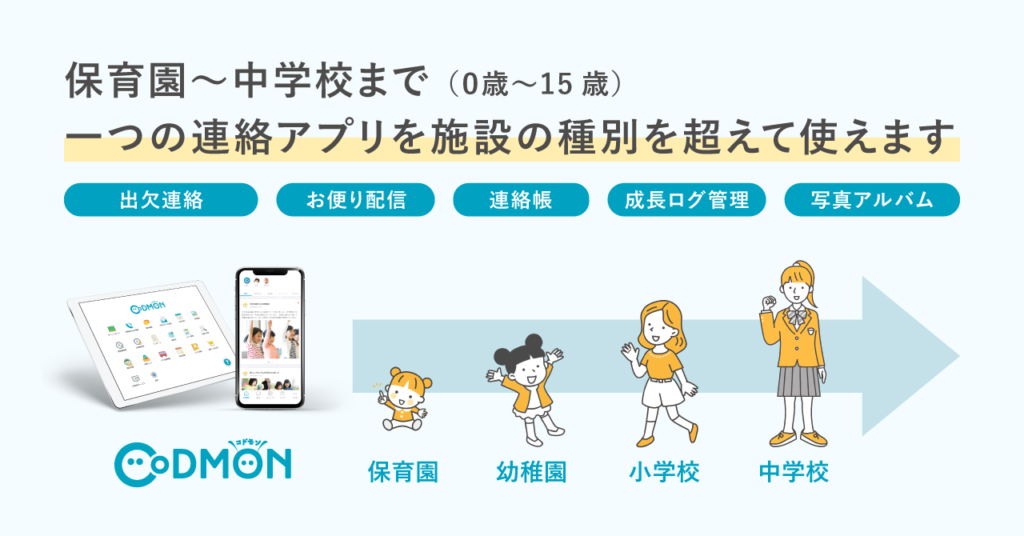
More than 300 municipalities have adopted the Digital Rural City National Concept.
The Digital Rural City National Concept by the Digital Agency aims to solve social issues such as declining population, falling birthrate, and aging population, and to improve the attractiveness of the region by actively promoting DX in the rural areas. One of the specific initiatives is to further "improve the quality" of childcare support (*3), and ICT services for childcare and education facilities are one of the means to achieve this. The Cabinet Office announced on March 18, 2022, "Determination of Projects Eligible for Grants to Promote the Digital Rural City National Concept," and projects utilizing ICT for childcare by municipalities that have introduced Codomon were also selected (*4).
List of adopted cases of municipalities introducing Codomon *Some excerpts
- Ueda City, Nagano "Project to Improve Parent Satisfaction through ICT in Public Nursery Schools".
- Hadano City, Kanagawa Prefecture "Utilization of a Childcare Support System Capable of Interactive Communication with Parents"
- Obu City, Aichi Prefecture "Obu City Comprehensive Childcare Operation Support System Construction Project
- Nisshin City, Aichi "Digitalization Solution for Communication between Schools and Parents".
(*3)P.67 "Basic Policy for the Digital Rural City State Concept", Cabinet Secretariat (June 7, 2022)
https://www.cas.go.jp/jp/seisaku/digital_denen/pdf/20220607_honbun.pdf
(*4)Cabinet Office, Office for Regional Development, "Determination of Projects Eligible for Grants to Promote the Digital Rural City State Initiative" (March 18, 2022).
https://www.chisou.go.jp/sousei/about/mirai/pdf/denenkouhukin_saitaku_type1_telework_r3.pdf
The "Secrets of Successful ICT Introduction" that Properly Penetrate the Workplace, According to a Municipal Childcare ICT Promotion Manager
On November 29, 2022, a roundtable discussion was held with two Codomon members and officials from Atami City, Shizuoka Prefecture and Shibata Town, Miyagi Prefecture. The discussion includes the impetus for introducing Codomon, what difficulties they encountered, how they overcame those difficulties, and the "secrets of successful ICT implementation," such as how they are glad they introduced Codomon.
The "Secrets of ICT Implementation" that Properly Penetrate the Workplace, According to an Interview with a Municipal Childcare ICT Promotion Managerhttps://newscast.jp/news/8359739
Roundtable Discussion Highlights
- starting point for an introduction
- The workload reduction of teachers in the field and the impact of the new coronavirus infection necessitated record management and rapid information dissemination tools and a means to inform parents of activities and children's condition in the facility.
- Difficulties encountered during implementation and how they were overcome
- We were able to negotiate smoothly by presenting the benefits of introducing ICT from the perspectives of both childcare workers and parents, and how it would allow them to spend more time with their children.
- The most difficult part was working with other departments. In order to overcome this, we involved staff members who were knowledgeable in the field and willing to digitize, and we worked together.
- Key Points for Smooth Introduction
- Clearly communicate the changes that will occur after the introduction of the system, and have a common understanding of the goals. To pick up and visualize what can be done to save labor, cost-effectiveness, labor cost reduction rate, etc.
- The "Teachers First" program will pick up the voices of the frontlines, and based on them, the administration will think about what should be done.
- Assign a teacher in charge of ICT at the site and entrust him or her with setting rules and maintaining the environment in the school.
◇ Utilization of SaaS for DXing of operations and business improvement
On September 1, 2021, the "Digital Agency" was established as a ministry to unify and promote the digitization of government administration, which had lagged behind other countries. The Ministry of Health, Labor, and Welfare (MHLW) has been conducting the "Study Group for Enhancing the Attractiveness of Childcare Workplaces and Occupations" since February 2020 to examine how to improve the attractiveness of the profession of "childcare worker" and of childcare centers as places to work and how to communicate this attractiveness, and the report released on September 30, 2020 (*1) also clearly states that the use of ICT is essential. The report (*1) released on September 30, 2020 clearly states that the use of ICT is indispensable. In addition, on October 20, the Ministry of Education, Culture, Sports, Science and Technology (MEXT) issued a notice (*2) to review parental stamps and promote digitization of communication at schools.
Childcare ICT comes in a variety of forms, and cloud services such as SaaS (*3) are being considered as a priority for use in a wide range of government information systems.
Improved efficiency: A wide variety of basic functions are provided in advance, which shortens the time required for implementation. Furthermore, since resources are shared among many users, the cost burden per user is reduced, and the system can be introduced at a relatively low cost.
Improved ability to respond to technological innovation: New features are added constantly, making it easy to take advantage of and experiment with the latest technologies.
Increased flexibility: Resources can be easily added, changed, etc., making it relatively easy to review operations, etc. This means that existing functions can be improved as needed based on user feedback.
Furthermore, when selecting a service from among several available services, the key point is that it has a sufficient track record. This is because a service with a proven track record is easier to use in the field, and active and continuous investment is made to add new functions, etc., and the risk of service termination is considered low (*4). (*4) These are important points not only for government information systems, but also for selecting ICT services for childcare and education facilities. The advantages of SaaS are also mentioned in the Ministry of Economy, Trade and Industry's "SLA Guidelines for SaaS." In addition to SaaS, there are other forms of ownership in which a system is built by customizing a packaged product to fit the company's own operations and specifications, but these not only take a long time to implement, but also require a large amount of time to build on the assumption that the scale of the target However, not only do these systems take a long time to implement, but they are also built on the assumption that the scale of the target business will expand, so there is a tendency to over-invest in line facilities and infrastructure. SaaS, however, is easy to implement and can be used even without in-house IT specialists (*5).
1 Report on the Attractiveness of Childcare Workplaces and Occupations, p. 19 2) Promote operational efficiency and business improvement through the use of ICT, etc.
https://www.mhlw.go.jp/content/11907000/000677595.pdf
2 Review of the seal required by schools for parents, etc. and promotion of digitization of means of communication between schools and parents, etc. (notice)
https://www.mext.go.jp/content/20201019-mxt_zaimu-100002245-1.pdf
3 SaaS refers to a system that provides application software functions to customers through a network as needed.
4 Basic Policy on the Use of Cloud Services in Government Information Systems, p. 5 "Column: Selecting Only the Right Cloud Services"
https://cio.go.jp/sites/default/files/uploads/documents/cloud_policy_20210330.pdf
5 SLA Guidelines for SaaS January 21, 2008
https://www.meti.go.jp/policy/netsecurity/secdoc/contents/downloadfils/080121saasgl.pdf

Codomon Corporation Company Profile
Location: 3F Mita 43MT Building, 3-13-16 Mita, Minato-ku, Tokyo
◆Capital: 68,250,000 yen
Representative: Yoshinori Koike, Representative Director
◆WEB:https://www.codmon.co.jp/
◆Business description: Engaged in projects to improve the environment surrounding children and embody the creation of an organization that is easy to work in for workers. Contribute to society by improving the environment from multiple perspectives to change society to be child-rearing friendly.
Codomon Services

Codomon Logo
ICT service for childcare and training facilities CoDMON
https://www.codmon.com/
This SaaS provides teachers and parents working in childcare and educational facilities with a variety of support tools so that they can spend more time with their children and have more peace of mind. The SaaS system provides functions such as smart recording of growth records and teaching plans linked to preschooler information, management of arrival and departure from preschool, and communication with parents to help create an environment that enhances the quality of childcare while greatly reducing the workload of teachers. As of August 2022, approximately 12,000 facilities and 200,000 childcare workers nationwide are using the system. Approximately 300 local governments nationwide have decided to introduce the system and conduct demonstration experiments. No. 1 in terms of market share* in terms of the number of facilities, the number of municipalities that have introduced the system, and the number of municipalities that have signed contracts (surveyed by Tokyo Shoko Research, Inc. in January 2022).
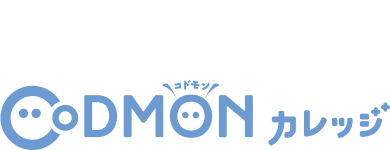
Codomon College Logo
■Training Services for Childcare Providers Codomon College
https://college.codmon.com/
An online training service that contributes to improving the qualifications and expertise of childcare workers in the field. The service provides learning opportunities through live training sessions and training videos that can be viewed at any time. All childcare professionals, regardless of whether they use ICT Codomon or not, can participate in the training free of charge.

Heusil Logo
■ Recruitment and childcare support service Hoisil
https://www.hoicil.com/
This is a "recruitment and preschool childcare recruitment support service" that connects parents and job seekers with childcare and educational facilities during childcare activities.
By creating and promoting a dedicated website that conveys the facility's appeal, local parents, job seekers, and childcare students can better find the right preschool for them. More than 2,200 facilities are using this system to prepare for the shortage of childcare staff and capacity due to the declining birthrate.

Sensei Prime Logo
Sensei Prime, a preferential program for all teachers
https://senseiprime.com/
Teachers" support the upbringing and learning of children, who are the bearers of the future. We want to create a society in which teachers, who are doing work of high social significance, are more valued and supported. We started this project with this in mind. We will sequentially offer programs throughout Japan to improve the treatment of employees at children's facilities, including childcare workers and teachers, by providing various preferential treatment throughout society.

Codomon Store Logo
■ E-commerce site for childcare facilities Codomon Store
https://store.codmon.com/
This e-commerce store handles hygiene products, toys, playground equipment, and facility equipment that are essential for facility operations. We carefully select and handle safe and durable products in consideration of the usage environment of children's facilities. All childcare facilities, regardless of whether they use ICT Codomon or not, are welcome to use the site.
<Inquiries, questions, etc.
Codomon Corporation
publicity
press@codmon.co.jp
080-7303-6026/080-4466-6738
TEL: 03-6459-4318
FAX: 050-3737-7471

